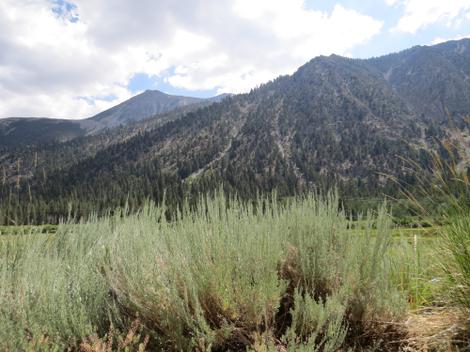
see also Habitats
California's Sagebrush Scrub Plant Community
Annual precipitation:
5-15 inches
Common Plants:
Big Basin Sagebrush (Artemisia tridentata), Rabbitbrush (Chrysothamnus nauseosus), Fourwing Saltbush (Atriplex canescens), Antelope Bush ( Purshia spp.)
Soil and climate notes:
Crummy climate, sometimes awful soil. Soil varies from acidic sands(granitic where water flows) to highly alkaline clays. Many of the areas have a pH of 9 on the surface,(highly alkaline) to 1000-10000 times more acidic 3 ft. down.(see Pull a soil analysis from different soil depths and any soil differences to see if it's good, bad or ugly. Climate can be worked with, but you have to pay attention.
The area below Pinyon-Juniper Woodland and above Joshua Tree Woodland is where the Sagebrush Scrub plant community usually exists.
This strip of a plant community, in some places like Lake Of the Woods, Quail valley or Lake Hughes may only be a valley a few hundred meters wide. In other areas like Owens Valley it may be 10 Kilometers wide. In southern California it is disjunct and spotty, existing in between the Yellow Pine Forests in areas like Mountain Springs. The Sagebrush Scrub plant community looks and feels like a low, cold, soft, gray chaparral plant community. A number of very cool perennials live in this plant community that happily live at lower elevations.
Our Penstemon 'Margarita BOP' is a hybrid from this area; Rydberg's Penstemon (Penstemon rydbergii var. oreocharis), and Sagebrush Penstemon (Penstemon speciosus) also come to mind.
Many ecologists include California's Sagebrush Scrub plant community in the Great Basin zone. Intermountain Flora separates the two and is probably right. The Great Basin is colder, harsher, and the growing season is later and shorter. The Sagebrush Scrub plant community usually has a faster draining, less alkaline soil and you can grow some excellent commercial crops like apples. Apples in the Great Basin are iffy at best. Native plants grow likewise; many of the species that can exist in places like Frazier Park, Susanville, or the Alabama Hills cannot survive the colder winters in the Great Basin. The opposite is often true; many of the Great Basin plant species cannot survive the hotter, drier, Sagebrush Scrub plant community of California. The Antelope Bushes (Purshia spp.) seem to be indicator plants. Purshia tridentata lives in the Great Basin, while Purshia glandulosa lives in the Sagebrush Scrub; hybrids of the two occur where they overlap. Both species wander into the Pinyon Juniper Woodland and even sometimes other close communities.
The creeks running down from the Sierra Nevada mountains support a wider range of species because the Sierran rainfall is acidic, while the natural soils of the area are slightly alkaline. In those areas you can find Golden Currant (Ribes aureum), Antelope Bush (Purshia tridentata var. glandulosa, Purshia mexicana var. stanburyana) and a number of other species hiding out.
Plants
A list of California native plants that grow in the Sagebrush Scrub plant community.






